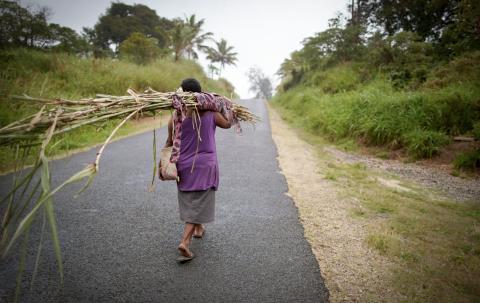Australia must soon decide how much it will contribute to the World Bank’s financing arm for the poorest and most vulnerable developing countries – known as the International Development Association, or IDA. IDA replenishments occur every few years. This time, the World Bank is looking for a record total of US$28-30 billion from donors in the face of stalling global development and escalating climate impacts. Domestic politics, tight government budgets, weaker currencies, and competing priorities across most major donors mean this a big ask.
Australia’s contributions to IDA have seen repeated cuts over the past decade. As a result, Australia has become a disproportionately small donor (shown in the chart below), falling from 12th in 2016 to 18th in the latest IDA donor rankings, despite currently having the 13th largest economy in the world.
Hitting the US$28-30 billion target would require Australia to pledge at least A$630 million – 30 per cent more than last time but similar as a share of the total Australian aid budget, given the increases since 2021. For an Australian government serious about buttressing the rules-based order and building an Australian development program fit for contemporary challenges, especially in the Pacific, there are strong reasons to at least meet this level of commitment.
First the basics. IDA is one of the most important elements of the global development financing architecture. It is the biggest source of grants and highly concessional loans for the poorest countries at around US$35 billion a year. Unlike various thematic mechanisms such as the Green Climate Fund with narrow donor-driven mandates, IDA provides financing based on a country’s own priorities, maintains a strong in-country presence, and plays a pivotal counter-cyclical role during crises. Unlike other funds it is also able to achieve massive leverage, providing three to four dollars to developing countries for every one dollar it receives from donors thanks to its hybrid financing model.
As an enormous, long-standing institution, there are invariably numerous complaints about the World Bank. Yet it is still considered one of the most effective development agencies – combining its financing with world class policy advice, research, and knowledge along with unmatched convening power.
Australia’s international development policy focuses on promoting better governance. But the need to compete with China for influence is a huge handicap.
Even facing a more constrained aid budget and intense geostrategic challenges in the region, the World Bank and IDA have much to offer in support of Australia’s interests.
IDA provided about US$600 million a year to the Pacific during 2021-22, with almost half of this in grants and the rest in highly concessional loans. A further US$800 million went to Southeast Asia. That’s much more than Australia’s US$180 million IDA pledge per year during that period.
Australia in the past successfully used its influence in IDA to push for special rules favouring small island economies, which are crucial to the Pacific. With IDA now under intense financial pressure, there is a risk this special treatment could be eroded. Australia’s influence in IDA is critical to protecting these rules, while there is also an opportunity to push for more funding for Pacific priorities such as disaster recovery and climate adaptation.
The World Bank, for its part, has a focus on ensuring a “liveable planet”, so it should heed these concerns given the Pacific’s status as the region most vulnerable to climate change.
Australian policymakers should also recognise that a strong rules-based development financing architecture is especially crucial in the Pacific during an age of intensifying geostrategic competition. As the most aid-dependent region in the world, the Pacific is particularly at risk from the ongoing securitisation of development.
The most important factor for development success or failure is the quality of a country’s policies and institutions. Australia’s international development policy focuses on promoting better governance. But the need to compete with China for influence is a huge handicap.
Can Australia realistically demand the mutual accountability of reform and good governance in exchange for its support? Or withhold this in its absence? Can Australia discourage politicians in partner countries from accepting unsustainable or otherwise problematic loans and projects from less scrupulous actors? Or will Australia simply repeatedly respond with its own dubious projects?
By contrast, the World Bank’s multilateral and technocratic nature give it a special role in encouraging good policies and discouraging bad ones – imposing reform requirements and its rules penalising unsustainable borrowing for example. The bank’s approach is not perfect or free from the pressure to stay on good terms with its clients. But that only makes it more important that Australia play its part in building a stronger and better World Bank as a vital strategic complement to its own bilateral efforts.
A second Trump presidency would likely deprioritise the World Bank, or worse. Even a Harris administration could struggle to get its full IDA commitments through Congress. European donors are unlikely to be ambitious. China meanwhile has been raising its influence and is already now one of the largest IDA donors.
Speaking to the United Nations General Assembly last year, Australia’s Foreign Minister Penny Wong emphasised that the world needs more from the multilateral development banks. If so, then Australia will need to do its part.


